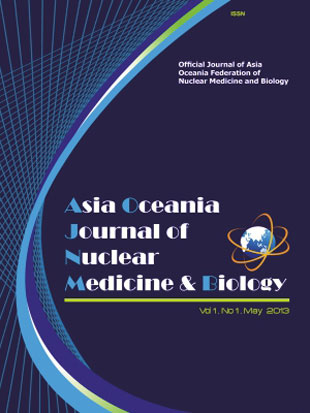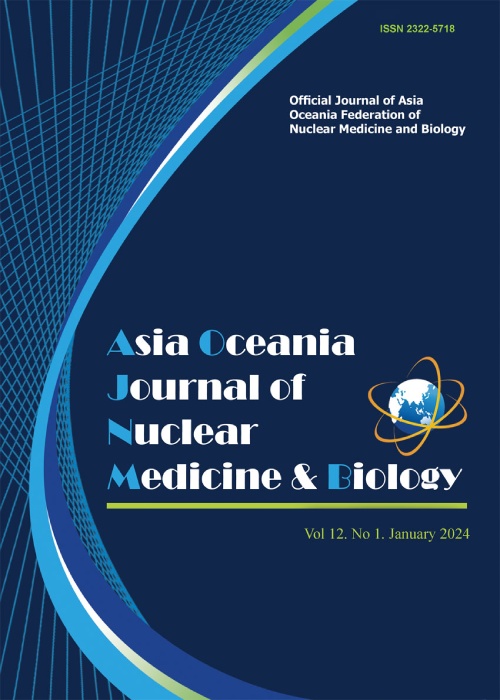فهرست مطالب

Asia Oceania Journal of Nuclear Medicine & Biology
Volume:1 Issue: 1, Winter 2013
- تاریخ انتشار: 1392/03/11
- تعداد عناوین: 9
-
-
Page 6ObjectiveResistance of metastatic lymph nodes (LNs) to high dose I-131 therapy is associated with high morbidity in patients with differentiated thyroid cancer. We evaluated the role of F-18 FDG PET/CT in the prediction of resistance to high dose I-131 therapy in patients with papillary thyroid cancer.MethodsThe subjects were 307 patients who underwent total or near total thyroidectomy followed by high dose (5.55-6.66 GBq) I-131 therapy. We divided the patients into three subgroups by visual assessment of regional LNs: FDG-avid LNs with a malignant shape on CT (PET/CT-positive group), FDG-avid LNs with a benign shape on CT (PET/CT-intermediate group) and no FDG-avid lesion (PET/CT-negative group). We measured the maximum SUV (SUVmax) of FDG-avid LNs in each patient. The presence or absence of focal increased uptake of I-131 was evaluated by whole body scan (WBS), and was denoted as WBS-positive group or WBS-negative group, respectively. Resistance to therapy was defined as presence of thyroglobulin (Tg) in serum (Tg ≥1.0 ng/ml) 3-6 months after I-131 therapy. Univariate and multivariate analyses were performed to determine the relationship between resistance to I-131 therapy and various clinico-pathologic variables.ResultsPET/CT-positive, intermediate, and negative groups included 20 (6.5%), 44 (14.3%) and 243 (79.2%) patients, respectively. The mean SUVmax was significantly higher in the PET/CT-positive group than that of the PET/CT-intermediate group (4.6 vs. 2.7, P <0.001). Univariate analysis revealed that the PET/CT-positive group (P <0.001), T2-4 stage (P <0.001), N1b stage (P = 0.001), lower dose (5.55 GBq) of I-131 (P <0.001), and the WBS-positive group (P = 0.029) were associated with resistance to therapy. In multivariate analysis, the PET/CT-positive group, lower dose of I-131, N1b stage, and T2-4 stage remained significant with odds ratios of 10.07 (P <0.001), 3.82 (P <0.001), 3.58 (P = 0.001), and 2.53 (P = 0.009), respectively.ConclusionFDG-avidity and malignant shape of cervical LNs on pre-therapy FDG PET/CT were a strong risk factors predicting resistance to high dose I-131 therapy. A lower dose of administered I-131 (5.55 GBq) and more extensive tumors (T2-4 and N1b) were also associated with resistance to high dose I-131 therapy.Keywords: F, 18 FDG PET, CT, resistance to I, 131 therapy, cervical lymph node, papillary thyroid cancer
-
Page 14ObjectiveAlthough coronary artery disease (CAD) is the leading cause of death in type 2 diabetic patients, it is frequently asymptomatic. Myocardial perfusion imaging (MPI) is reported to show ischemia in a significant number of asymptomatic diabetic patients. We studied the prevalence and severity of myocardial perfusion defects in asymptomatic diabetic patients and its clinical impact. Methods and patients: One hundred thirty consecutive asymptomatic patients, aged 35-65 years with type 2 diabetes mellitus and with no history of CAD and no cardiac symptoms were recruited in the study. Echocardiography, electrocardiography (ECG), routine laboratory tests and exercise treadmill test (ETT) were performed and patients with weakly positive or negative ETT underwent Dipyridamole MPI. Patients with positive ETT were referred to coronary angiography. Patients were followed for at least 17 months (mean 21.7 months) and any cardiac event was recorded.ResultsWe studied 81 female and 49 male patients with mean age of 51.8 years. Negative, weakly positive and positive ETT result was noted in 74.3%, 15% and 10.7% respectively. 75% of patients with positive ETT had coronary artery disease in angiography. Gated myocardial perfusion SPECT was done in 106 patients. MPI showed reversible defect in 26.9% of the patients with a mean summed stress score of 3.3±1.8. Follow up completed in 112 patients and only one patient with abnormal MPI underwent coronary angiography followed by PTCA. No cardiac death, MI, UA or hospital admission occurred among our patients during follow up (17-26 months). Mean stress end diastolic volume (EDV) was significantly higher in patients with reversible defect compared to patients without reversible defect based on MPI findings (62.0±31.6 Vs 48.5±18.4 ml, P=0.04). Blood glucose and HA1c were significantly higher in patients with ischemia compared to patients without ischemia (P<0.05). Meanwhile the ratio of TG to HDL was 6.06±3.2 in ischemic patients compared to 4.8±2.3 in normal subjects (P=0.03).ConclusionReversible defects are commonly seen in myocardial perfusion SPECT in asymptomatic diabetic patients and are mild in severity and not associated with adverse cardiac events. Routine approach for detection of CAD beginning with ETT seems to be appropriate in these patients.Keywords: Coronary artery disease, Diabetes mellitus, Gated myocardial perfusion SPECT, Silent Ischemia
-
Page 20ObjectiveThe current study aimed to determine the efficacy of radioiodine-131 (131I) ablation therapy with thyroid hormone replacement one day before 131I administration in patients with well-differentiated thyroid cancer (DTC).MethodsThis retrospective study included 29 patients who underwent 131I therapies twice for DTC during 6-12 months. Since all the patients obviously had residual lesions by their serum thymoglobulin levels or their scintigrams at the first therapies, they underwent the second 131I therapies without diagnostic scintigraphy after the first therapies. After confirming the sufficient elevation of TSH concentration, thyroid hormone replacement was resumed one day before 131I administration (3.7-7.4GBq). The ablation rate of thyroid remnant at the first 131I therapy was evaluated by comparing 131I post-therapeutic images of the two treatments.ResultsThree patients were administrated thyroid hormone after 131I therapy because of insufficient TSH concentration under thyroid hormone withdrawal. In the remaining 26 patients, 41 thyroid remnant accumulations were detected in all 26 patients at the first 131I therapy. Based on the second 131I post-therapeutic images, successful ablation was confirmed in 24 of 26 patients (92.3%) and 38 of 41 sites (92.7%), which was comparable with historically reported ablation rates.ConclusionThyroid hormone replacement one day before 131I therapy could provide a sufficiently high ablation rate in patients with DTC.Keywords: thyroid cancer, 131I, hormone, replacement
-
Page 27IntroductionInvolvement of the skeleton can cause an excruciating pain in two-thirds of terminal patients with a history of malignancy. Due to several limitations of other therapies, such as analgesics, bisphosphonates, chemotherapy, hormonal therapy and external beam radiotherapy; bone-seeking radiopharmaceuticals have an important role in palliation of pain from bone metastases. Although these kinds of therapies have many advantages including the ability to treat multiple sites of tumoral involvement simultaneously, no significant confliction with other treatments, ease of administration and the potential to be used repetitively; in Iran using of this modality is not widely practiced. In this study we evaluated the clinical usefulness of Sm-153 lexidronamfor pain management of bone metastases.Methods28 patients (14 males and 14 females) aged 38-77 years with a history of painful bone metastases caused by different cancers, not responding to conventional treatments were included in the study. All patients had a recent whole body bone scan indicating multiple bone metastases. 1 mCi/Kg Sm-153 lexidronam was injected intravenously to the patients. Whole body scintigraphy was done 3 or 18 hours post injection. Pain relief and quality of life have been evaluated by analog pain scale and Karnofsky index every week, respectively. Also, all patients were evaluated for hematological toxicity every two weeks. Active follow ups were performed.Results43% of patients showed the presence of the flare phenomenon during the first three days after Sm injection with a mean duration of 2.2 days. The pain relief began between 2 and 16 days post injection and the duration of pain palliation was in the range of 4 to 32 weeks (mean±SD=15.22±7.8). 64.3% of patients showed complete relief of pain and 21.4% achieved partial response to therapy. (Over all response to therapy was 85.7%). The lowest amount of peripheral blood cells was detected in the fourth week for RBCs and in the 6th week for WBCs and PLTs. No one experienced hematological toxicity induced problems.ConclusionSm-153 lexidronam is an effective treatment for painful bone metastases. The complication rate is low and the quality of life of the patients after treatment would be significantly improvedKeywords: Radionuclide Therapy, Samarium, 153Sm, EDTMP, painful bone metastasis
-
Page 32This study describes the organic synthesis of 5-(2-amimo-4-styryl pyrimidine-4-yl)-4-methoxy benzofuran-6-ol (SPBF) as an example of a benzofuran derivative used as a new series of amyloid imaging agents. These benzofuran derivatives may be useful amyloid imaging agents for detecting B-amyloid plagues in the brain of Alzheimer’s disease. The precursor is 1-[6-hydroxy-4-methoxybenzofuran-5-yl]-phenyl butadiene ketone, which react with guanidine hydrochloride. The purification process was done via crystallization using solvent ethanol. The overall yield was 75% and the structure of the synthesized compound was confirmed by correct analytical and spectral data. Also, The synthesized compound was labeled with radioactive iodine -125 via electrophilic substitution reaction, in the presence of iodogen as an oxidizing agent, the labeling process was carried out at 95oC for 20min. The radiochemical yield was determined by using a thin layer chromatography and the yield was equal to 80%. Preliminary an in-vivo study examined normal mice after intravenous injection through the tail vein and the data showed the labeling compound was quickly cleared from most body organs. The radioiodinated compound showed high brain uptake.The results of this study suggest that radioiodinated (SPBF) may be useful as a brain imaging agents.Keywords: Benzofuran derivatives, Iodine, 125, imaging agents, Tissues distribution
-
Page 39Mitochondria play an important role in energy production for the cell. The proper function of a myocardial cell largely depends on the functional capacity of the mitochondria. Therefore it is necessary to establish a novel and reliable method for a non-invasive assessment of mitochondrial function and metabolism in humans. Although originally designed for evaluating myocardial perfusion, 99mTc-MIBI can be also used to evaluate cardiac mitochondrial function. In a clinical study on ischemic heart disease, reverse redistribution of 99mTc-MIBI was evident after direct percutaneous transluminal coronary angioplasty. The presence of increased washout of 99mTc-MIBI was associated with the infarct-related artery and preserved left ventricular function. In non-ischemic cardiomyopathy, an increased washout rate of 99mTc-MIBI, which correlated inversely with left ventricular ejection fraction, was observed in patients with congestive heart failure. Increased 99mTc-MIBI washout was also observed in mitochondrial myopathy, encephalopathy, lactic acidosis and stroke-like episodes (MELAS) and in doxorubicin-induced cardiomyopathy. Noninvasive assessment of cardiac mitochondrial function could be greatly beneficial in monitoring possible cardiotoxic drug use and in the evaluation of cardiac damage in clinical medicine.Keywords: mitochondria, 99mTc, MIBI, ischemic heart disease, heart failure, cardiomyopathy
-
Page 44
Ectopic thyroid tissue results from abnormal embryologic development and migration of the thyroid gland. True malignant transformation in ectopic thyroid tissue is extremely rare and is always diagnosed after surgical excision of the lesion by pathology examinations. There are well-documented cases of ectopic thyroid cancer while primary tumoral lesion occurs in the orthotopic thyroid, but only rare cases of ectopic PTC without any evidence of occult thyroid cancer in the orthotopic thyroid or cervical lymph nodes have been reported. We report on a 39 year old woman who was operated for a mediastinal mass. The initial diagnosis was a malignant thymic lesion, which was later confirmed to be a papillary thyroid carcinoma. Consequently, total thyroidectomy was performed and pathology report showed normal thyroid tissue with no evidence of any neoplastic involvement. Until now, only one similar case has been reported.
Keywords: Papillary thyroid carcinoma, Ectopic PTC, Ectopic thyroid, mediastinal mass


